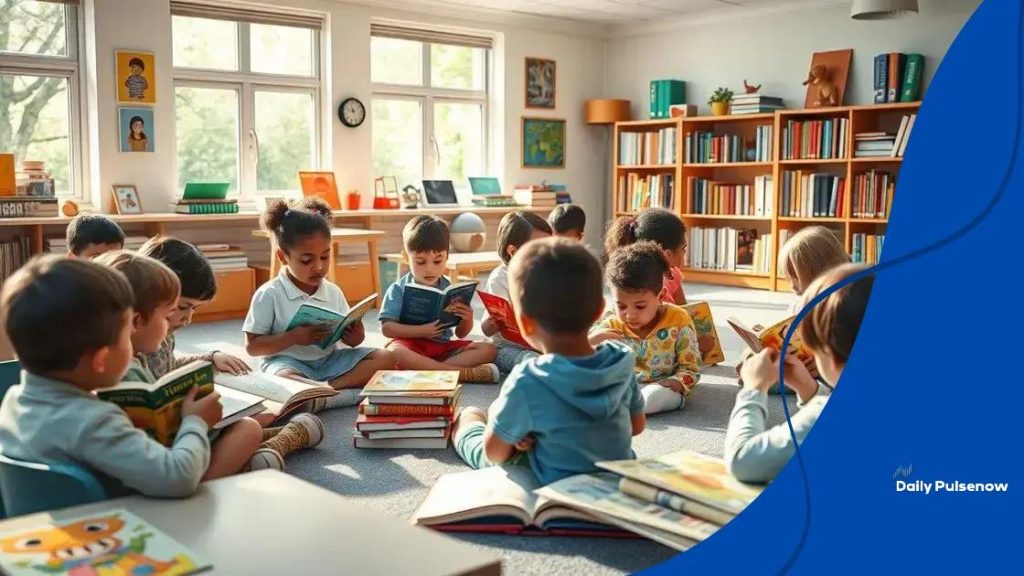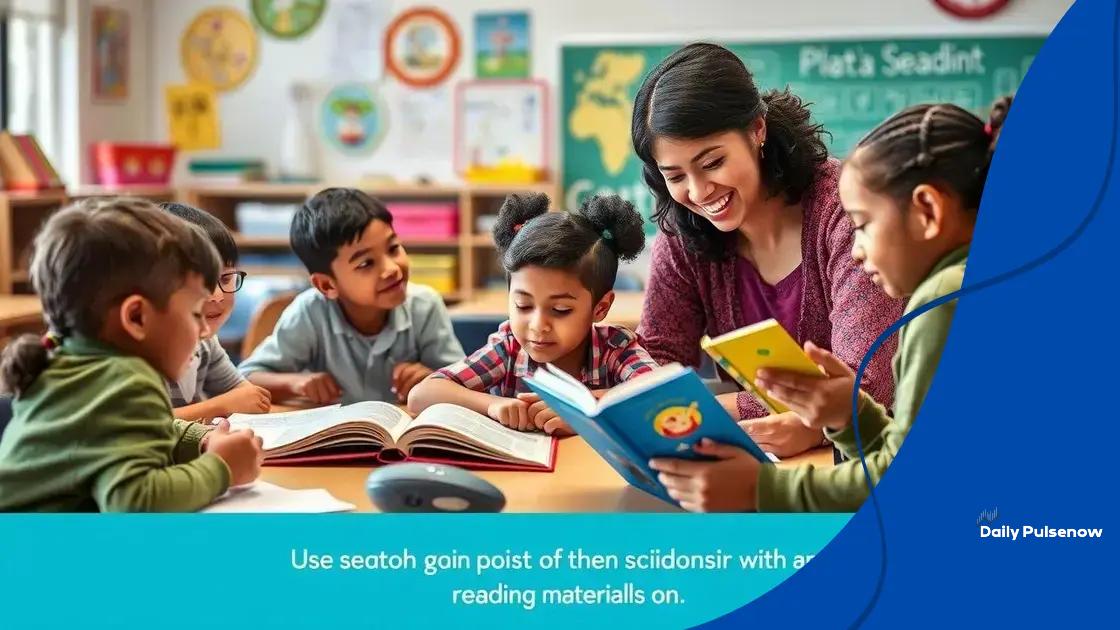Scholastic United States of Readers expansion unlocks potential

Anúncios
The Scholastic United States of Readers expansion aims to improve student literacy by integrating technology, promoting inclusivity in reading materials, and supporting educators through collaborative practices.
Scholastic United States of Readers expansion presents a unique opportunity to enhance reading skills among students. Have you ever wondered how innovative programs can transform education? Let’s dive into the possibilities!
Anúncios
Understanding the Scholastic United States of Readers program
The Scholastic United States of Readers program is designed to enhance literacy among students of various ages. This initiative emphasizes the importance of reading in developing critical thinking and communication skills. By focusing on engaging content, it aims to make reading exciting and accessible for everyone.
Key Components of the Program
The program includes various key elements that promote reading engagement. These components work together to create a comprehensive learning experience.
- Interactive materials that captivate students’ interest
- Tailored resources for different reading levels
- Support for educators through training and workshops
- Incentives to motivate students to read more regularly
Each of these elements contributes to making the program effective. Furthermore, educators benefit from continuous support and resources that facilitate the integration of the program into their classroom settings.
Anúncios
Benefits of Participation
Participating in the Scholastic program can lead to numerous advantages for students and teachers alike. For instance, students often show increased enthusiasm towards reading when they are part of such initiatives. The program promotes a positive reading culture, which is essential for personal growth and academic success.
More importantly, it encourages collaboration among peers as they explore various texts together. This collaborative atmosphere allows students to share insights and discoveries. As a result, they not only enhance their language skills but also foster a love for reading that persists beyond the classroom.
In summary, the Scholastic United States of Readers program provides valuable tools and resources to cultivate literacy. By engaging students and educators, it helps to build a community centered around the joy of reading, ultimately paving the way for lifelong learning.
Key objectives of the expansion initiative
The key objectives of the expansion initiative within the Scholastic United States of Readers program are crucial for enhancing literacy skills among students. This initiative aims to create a comprehensive framework that supports both students and educators in the reading journey.
Focus Areas of the Initiative
One of the primary goals is to foster a love for reading. This is achieved through engaging materials that resonate with students. The program places emphasis on offering resources that cater to various reading levels and interests.
- Developing reading fluency and comprehension
- Providing access to diverse literary genres
- Encouraging parental involvement in reading activities
- Building a community of readers through events and programs
Additionally, the initiative seeks to empower educators by providing them with training and support. This ensures that teachers have the tools necessary to create effective reading environments.
Impact on Literacy Development
The ultimate goal is to improve literacy rates across the board. By targeting different aspects of reading education, this initiative aims to address the unique needs of every student. For instance, interventions for struggling readers allow them to catch up with their peers.
The expansion also aims to include technology and digital resources, making reading more accessible for all students. Integrating technology into the learning process can spark greater interest and engagement among learners.
By aligning the objectives with the latest educational standards, this initiative stands to make a significant impact on students’ reading skills and overall academic performance.
Impact on students and educators

The impact of the Scholastic United States of Readers expansion on both students and educators is significant. This initiative transforms how reading is taught and experienced in classrooms. It addresses the diverse needs of learners and empowers educators with effective strategies.
Benefits for Students
Students experience a boost in their reading skills through engaging materials that captivate their interest. The program encourages a love for reading, motivating students to explore new genres and authors.
- Improved comprehension and fluency in reading
- Increased confidence in their reading abilities
- Stronger critical thinking and analytical skills
- Access to a variety of reading materials, including digital resources
Moreover, by participating in collaborative reading activities, students develop social skills and learn to appreciate different perspectives. This collaborative approach fosters a sense of community and belonging in the classroom.
Support for Educators
For educators, the initiative provides essential support through training and resources that amplify their teaching methods. With access to high-quality content and curriculum materials, teachers can design effective reading programs that resonate with their students.
Professional development opportunities offered through the program enable educators to stay current with best practices in literacy education. By incorporating new strategies and technologies, teachers can create dynamic lessons that engage students.
The initiative also promotes collaboration among educators, allowing them to share successful practices and ideas. This sharing of resources and strategies can lead to improved teaching outcomes and a positive impact on student performance.
Integration with existing curricula
The integration with existing curricula is a vital aspect of the Scholastic United States of Readers expansion. This program aims to seamlessly blend with current teaching practices and subjects, promoting literacy across various disciplines.
Aligning Objectives
One of the main goals is to ensure that the reading materials align with the educational standards already in place. By evaluating existing curricula, the initiative helps in identifying suitable literature and educational tools for integration.
- Selection of texts that enhance required learning outcomes
- Incorporating cross-curricular themes to enhance understanding
- Facilitating project-based learning through reading
- Connecting literature with real-world applications
This alignment makes it easier for teachers to adopt new resources without overhauling their entire curriculum. Teachers can introduce engaging materials that fit naturally into their lesson plans.
Collaborative Planning
Collaboration among educators is emphasized to create cohesive lesson plans. Teachers across different subjects can work together to identify themes and topics that complement each other. This teamwork allows for a richer learning experience.
Furthermore, professional development sessions encourage discussion about best practices for integrating new resources. Educators can share strategies that have proven successful in their classrooms, fostering an environment of continuous improvement.
Through these collaborative efforts, reading becomes an integral part of the school day, enhancing student engagement and learning outcomes across various subjects. The goal is not only to improve reading skills but also to deepen understanding in other areas of study.
Future directions for reading programs
The future directions for reading programs play a crucial role in shaping how literacy is approached in education. As technology and educational needs evolve, new strategies must emerge to keep reading relevant and engaging for students.
Embracing Technology
One significant trend is the integration of technology into reading programs. Digital books, interactive apps, and online resources transform how students access literature. These tools can enhance engagement and provide personalized reading experiences.
- Utilizing adaptive learning technologies to tailor reading materials
- Promoting digital literacy alongside traditional reading skills
- Encouraging the use of audiobooks and e-books for diverse learning styles
- Fostering online reading communities that connect students
As educators adopt these technologies, they are better equipped to meet the varied needs of their students.
Fostering Inclusivity
Another critical direction involves creating more inclusive reading programs. This includes providing materials that reflect the diverse backgrounds and experiences of all students. Books featuring various cultures, perspectives, and characters help students relate to what they read.
Additionally, schools are focusing on selecting texts that promote empathy and understanding. Fostering a more inclusive reading environment can improve students’ connection to literature, ultimately boosting their engagement and comprehension.
By tapping into the rich diversity of stories available, educators can inspire a love of reading among their students.
Overall, the future of reading programs lies in blending technology with inclusivity. By understanding students’ needs and leveraging innovative resources, schools can create dynamic literacy experiences that prepare students for lifelong learning.
In conclusion, the Scholastic United States of Readers expansion represents an important step forward in improving literacy among students. By integrating technology and promoting inclusivity, reading programs can better engage students and support their learning journeys. As we continue to adapt to the needs of learners, fostering a love for reading while providing access to diverse materials will ensure that all students can thrive. The future of literacy education is bright, and together, we can help shape a new generation of enthusiastic readers.
FAQ – Frequently Asked Questions about Scholastic United States of Readers Expansion
What is the goal of the Scholastic United States of Readers expansion?
The goal is to improve literacy skills among students by providing engaging reading materials and resources that cater to diverse learning needs.
How does technology play a role in reading programs?
Technology enhances reading programs by integrating digital tools, offering interactive resources, and personalizing learning experiences for students.
Why is inclusivity important in reading materials?
Inclusivity ensures that all students can relate to the content, fostering a sense of belonging and encouraging greater engagement with reading.
How can educators collaborate to enhance literacy education?
Educators can share best practices, resources, and innovative strategies during professional development sessions to create cohesive literacy programs.